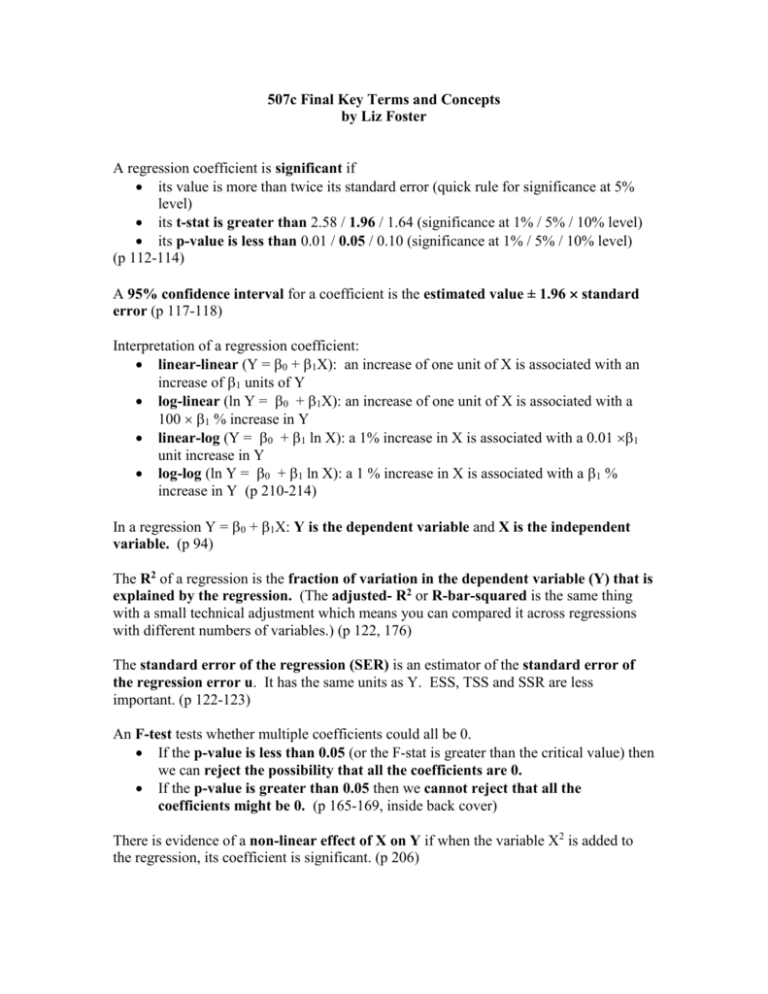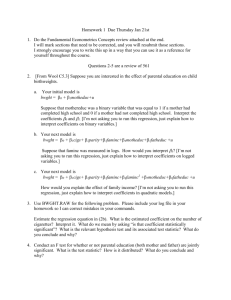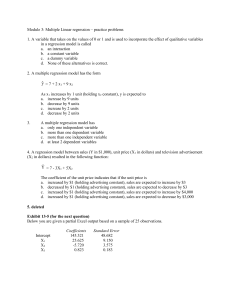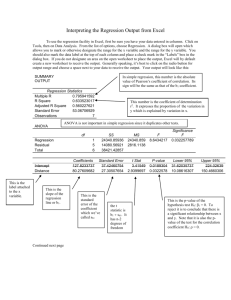507c Final Key Terms and Concepts
advertisement

507c Final Key Terms and Concepts by Liz Foster A regression coefficient is significant if its value is more than twice its standard error (quick rule for significance at 5% level) its t-stat is greater than 2.58 / 1.96 / 1.64 (significance at 1% / 5% / 10% level) its p-value is less than 0.01 / 0.05 / 0.10 (significance at 1% / 5% / 10% level) (p 112-114) A 95% confidence interval for a coefficient is the estimated value ± 1.96 standard error (p 117-118) Interpretation of a regression coefficient: linear-linear (Y = 0 + 1X): an increase of one unit of X is associated with an increase of 1 units of Y log-linear (ln Y = 0 + 1X): an increase of one unit of X is associated with a 100 1 % increase in Y linear-log (Y = 0 + 1 ln X): a 1% increase in X is associated with a 0.01 1 unit increase in Y log-log (ln Y = 0 + 1 ln X): a 1 % increase in X is associated with a 1 % increase in Y (p 210-214) In a regression Y = 0 + 1X: Y is the dependent variable and X is the independent variable. (p 94) The R2 of a regression is the fraction of variation in the dependent variable (Y) that is explained by the regression. (The adjusted- R2 or R-bar-squared is the same thing with a small technical adjustment which means you can compared it across regressions with different numbers of variables.) (p 122, 176) The standard error of the regression (SER) is an estimator of the standard error of the regression error u. It has the same units as Y. ESS, TSS and SSR are less important. (p 122-123) An F-test tests whether multiple coefficients could all be 0. If the p-value is less than 0.05 (or the F-stat is greater than the critical value) then we can reject the possibility that all the coefficients are 0. If the p-value is greater than 0.05 then we cannot reject that all the coefficients might be 0. (p 165-169, inside back cover) There is evidence of a non-linear effect of X on Y if when the variable X2 is added to the regression, its coefficient is significant. (p 206) For a regression Y = 0 + 1X + 2W + 3XW : there is evidence for an interaction of between X and W (or that the effect of X on Y depends on W) if the coefficient of the interaction term X W is significant. (If X is included as X, X2, X3 … interaction terms between W and all the powers of X must be included and an F-test done on all the interaction terms) (p 218-229) Difference in Differences The following table gives average or predicted values of Y for 4 groups: X=1 X=0 W=1 1 2 W=0 3 4 The difference in differences is (1 - 3) - (2 - 4). This should be the same as the value of 3 in the regression Y = 0 + 1X + 2W + 3XW The error term is homoskedastic if the variance of Y is the same for different values of X (ie, the variance of test scores is the same for kids in small classes as large classes). heteroskedastic is the variance of Y is different for different values of X. If you assume homoskedasticity wrongly, your standard errors will be too small (but your coefficient unbiased). If you allow for heteroskedasticity, your standard error will be right even if the error term is really homoskedastic. (p 124-126, 129) You have omitted variable bias is there is some factor that is correlated with your independent variables (X etc) and influences the dependent variable Y but is not included in the regression. This means that your coefficients are, on average, wrong. If X is truly randomly assigned then you don't have OVB. (p 144-147) To derive an OLS estimator for a regression Y = f(X,) + u where you get to pick : 1. Set up what you want to minimize : (Y – f(X, ) )2 2. Take the derivative with respect to and set = 0. 3. Solve for . To prove an estimator -hat is unbiased 1. Use Y = f(X,) + u to write -hat in terms of , X and u – preferably as + some expression in X and u. 2. Take expectations. 3. Use LIE to replace u with E[u | X]. 4. Use the first assumption to say that E[u | X] = 0 and simplify. (p 135-137) Remember: E[a+bX] = a + bE[X] var(a+bX) = b2 var(X)) var(X) = E[(X-)2] = E[X2] – (E[X])2 If A and B are normally distributed with means ma and mb and variance sa and sb (standard errors ea and eb) then A-B is normally distributed with mean ma-mb and variance sa+sb (standard error (ea + eb) )











